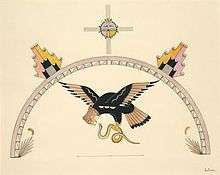Awa Tsireh
| Awa Tsireh | |
|---|---|
 Photo postcard of Awa Tsireh in Plains Indian attire, ca 1930s, at Manitou, Colorado. | |
| Born |
Alfonso Roybal, Cattail Bird February 1, 1898 San Ildefonso Pueblo |
| Died |
March 30, 1955 San Ildefonso Pueblo |
| Known for | Painting |
| Movement | San Ildefonso Self-Taught Group |
| Awards | Ordre des Palmes Académiques, 1954 |
| Patron(s) | Edgar Lee Hewett, Alice Corbin |

Awa Tsireh (February 1, 1898 – March 30, 1955),[2] was a San Ildefonso Pueblo painter also known as Alfonso Roybal[3] and Cattail Bird. He was part of the art movement known as the San Ildefonso Self-Taught Group.
Early life
Awa Tsireh's family was very active in the arts. His parents were Alfonsita Martinez, a native potter, and Juan Estaba Roybal, the nephew of the known potter, Cresencio Martinez.[4] His nephew was pueblo painter, José Disiderio (J.D.) Roybal.[5]
He was one of the earliest of the San Ildefonso painters and his formal education did not extend past grade school.[6]
In 1917, American artist William Penhallow Henderson painted a portrait of young Awa Tsireh which can now be found in the New Mexico Museum of Art.[7] Henderson's wife, Alice Corbin Henderson, was a patron of Awa Tsireh.[8]
In 1920 he married a woman from the village. The following year she gave birth to a son, but mother and child died soon after. Affected greatly, Awa Tsireh moved to his parents' home.[9]
Work
Awa Tsireh had the support of Dr. Edgar Lee Hewett, who provided studio space for him in the Palace of the Governors.[10] His art is in the permanent collection of several museums, including the Smithsonian American Art Museum.[11]
At various times in his life, Awa Tsireh was a farmer, a pottery painter, a museum employee, a painter, a silversmith and a muralist.[12] One of his most notable artistic commissions was for a mural at Maisel's Indian Trading Post in Albuquerque, New Mexico where murals depicting Indian life, painted by Pueblo and Navajo artists, were prominently displayed.
Metalwork
It is not known when, or from whom, Awa Tsireh learned silversmithing but by 1931 newspaper articles described him as a painter, silversmith and dancer. Around 1930 he began working in the summer months at Garden of the Gods Trading Post in Colorado Springs, and was employed there for at least two decades.[9] His sister, Santana Martinez, recalled that "during the summer during the thirties and forties he used to go to a shop in Colorado Springs and do paintings and silverwork there."[13] He worked in silver, copper, nickel silver and aluminum.
Media
Tsireh worked in watercolor and in transparent colored ink and pencil. He also created silver and gemstone pieces of art. Awa Tsireh painted in 3 different styles; a simple realism, a combination of symbolism and realism, and a completely non-realistic style, per Samuels' Encyclopedia of Artists of the American West, (1968).
Awards
- EITA, Exposition of Indian Tribal Arts, sponsored by the College Art Association, 1931–33
- SWAIA, Southwestern Association on Indian Affairs, Santa Fe, New Mexico
- AIW, American Indian Week, Tulsa, Oklahoma
Honors
- 1954 – Palmes d' Academiques, from the French Government[14]
References
- ↑ http://www.dbknews.com/archives/article_c0c7cd78-575c-11e5-a08a-c3a0a6c8fdca.html September 9, 2015
- ↑ "The Modern Pueblo Painting of Awa Tsireh". Smithsonian American Art Museum. Retrieved 2016-01-11.
- ↑ "Awa Tsireh, American Art". Smithsonian American Art Museum. Retrieved 2016-01-11.
- ↑ Henderson, Alice Corbin (6 September 1925). "The World of Art : A Boy Painter Among the Pueblo Indians and Unspoiled Native Work". The New York Times Magazine.
- ↑ "Untitled (clown dancer) by JD Roybal". Harwood Museum. Retrieved 2016-01-11.
- ↑ "Alfonso Roybal, Native American Painter". Adobe Gallery, Santa Fe. Retrieved 2016-01-13.
- ↑ "Awa Tsireh (1917)". SAM | Searchable Art Museum. New Mexico Museum of Art. Retrieved 2016-01-12.
- ↑ St. James Guide to Native North American Artists. Detroit, MI: St. James Press. 1998. p. 38. ISBN 1558622217.
- 1 2 Messier, Pat & Kim (2014). Reassessing Hallmarks of Native Southwest Jewelry. Atglen: Schiffer Publishing. pp. 88–91. ISBN 978-0-7643-4670-5.
- ↑ "Dead Indian Identified as Top Artist". The New Mexican. March 31, 1955.
- ↑ "Awa Tsireh Artwork". Smithsonian American Art Museum. Smithsonian American Art Museum. Retrieved 5 June 2015.
- ↑ "Awa Tsireh". Askart.com. Retrieved 2016-01-11.
- ↑ Seymour, Tryntje Van Ness (1988). When the Rainbow Touches Down. Phoenix: The Heard Museum. p. 156. ISBN 0-934351-01-5.
- ↑ Lester, Patrick D. (1995). The Biographical Directory of Native American Painters (BDNAP) (1st ed.). Tulsa, Oklahoma: SIR Publications. ISBN 978-0-8061-9936-8.
External links
• Awa Tsireh art collection at the Smithsonian American Art Museum